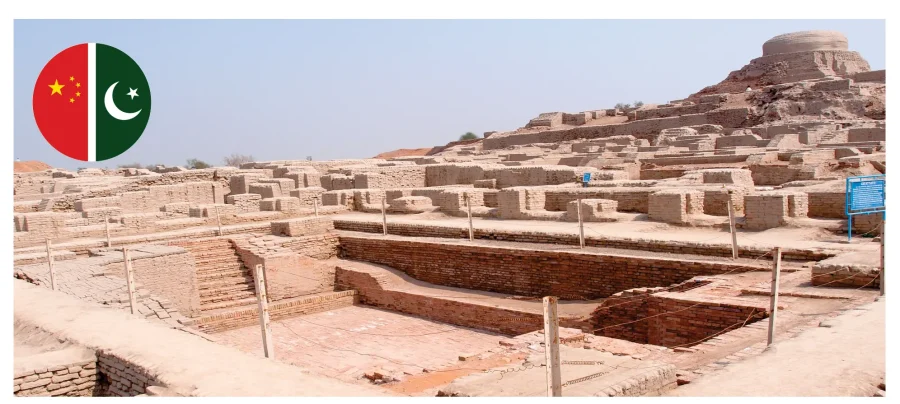The project of Historical Cities Studies (HCS) along the Belt and Road Initiative (BRI) holds considerable significance due to its exploration of interconnections between capital concentration, human settlement patterns, hunting to gathering modes, modes of production and historical materialism within the context of the Indus Valley Civilization. This endeavour delves into the early stages of urbanization, the emergence of world civilizations, the formation of new historic urban clusters and the importance of conserving heritage for integrated and sustainable development. Notably, China’s successful efforts in reorganizing historic cities along the Yellow River Valley and Yangtze River Valley, integrating them into cultural and economic belts, provide valuable lessons for regional development. This article examines the key strategies and policy interventions that contributed to China’s achievements and assesses their adaptability to the BRI region. Historic cities and towns represent tangible remnants of our past, reflecting the social, cultural and economic dynamics that have shaped human history. The process of urbanization has played a pivotal role in the evolution of societies, making cities the legitimate unit of analysis to understand a spectrum of human relationships. The present article aims to explore the significance of Historical Cities Studies, focusing on the early stages of urbanization and their implications for world civilizations with a particular focus on the Indus Valley Civilization and the broader Belt and Road Initiative (BRI) region. The study of these cities goes beyond merely understanding their architecture and urban planning; it offers profound insight into human relationships, modes of production and the evolution of civilizations. This article centres on the Indus Valley Civilization as a case study to explore the intricate interconnections between historic cities, capital concentration, human settlement patterns, hunting to gathering modes, modes of production and historical materialism.
The Belt and Road Initiative (BRI) is a significant global development project aimed at enhancing connectivity and promoting economic cooperation among countries along its routes. China’s policy of heritage preservation bodes well for safeguarding the heritage of historic cities of the Indus Valley Civilization along the BRI. By linking heritage tourism and conservation strategies to the local economy, sustainable development can be achieved. Additionally, the role of UNESCO in preserving world heritage and the importance of local political and economic alignment in historic city projects are of paramount significance. The China-Pakistan Economic Corridor (CPEC), being part of the BRI, connects the Indus Valley Civilization, one of the world’s oldest urban civilizations which thrived around 3300-1300 BCE along the Indus River Basin thousands of years ago. Archaeological sites such as Taxila, Mohenjo-daro and Takhtbai hold immense historical value and are crucial for understanding the region’s cultural heritage. The Indus Valley Civilization witnessed the rise of sophisticated urban centres like Harappa and Mohenjo-Daro, which showcased advanced town planning, sanitation systems and a complex social hierarchy. The concentration of population in these cities led to the development of specialized trade, craftsmanship and an early form of the division of labour.
Preserving historic cities through heritage tourism can attract visitors to these historical sites, allowing them to experience and appreciate their cultural value. By incorporating heritage tourism into a comprehensive strategy, the BRI/CPEC can achieve sustainable development by leveraging the economic opportunities it brings. Sustainable tourism ensures that the preservation and promotion of historical sites benefit both local communities and tourists without compromising the cultural significance of the sites. An economically viable heritage conservation strategy is essential for long-term sustainability. Integrating heritage tourism into the local economy can create various economic opportunities, such as hospitality services, souvenir shops, local handicrafts and cultural events. The economic benefits generated from tourism can then be reinvested into the conservation and maintenance of historic cities.
The United Nations Educational, Scientific and Cultural Organization (UNESCO) plays a crucial role in identifying and safeguarding world heritage sites. UNESCO’s World Heritage List includes several sites from the Indus Valley Civilization, recognizing their universal cultural value. Through its programs and initiatives, UNESCO contributes significantly to the preservation and promotion of these sites for future generations. To foster a sense of belonging in the upcoming generations, the HCS project must actively involve local communities in decision-making processes, thereby strengthening their feeling of ownership and responsibility towards their heritage. Empowering locals through various measures, such as educational programs, cultural events and employment opportunities, can deepen their connection to the historic sites.
Preserving the cultural heritage of historic cities is vital for sustainable development. By conserving architectural marvels, artefacts and cultural traditions, these cities can attract global attention, boost tourism and generate economic opportunities for local communities. Simultaneously, integrating modern amenities and sustainable practices into these historic urban clusters ensures a harmonious co-existence of tradition and progress.
In the present neo-liberal era, historic cities, once based on shared opportunities and meeting people’s needs, have undergone transformation due to the interplay of various economic and political forces. Marxist and Gramscian perspectives highlight the struggle between social classes for control over historical narratives, while neoliberalism has turned historic cities into commodities for economic gain. It is essential to consider these impacts when formulating conservation strategies to ensure a balanced and inclusive approach. Historical materialism, a fundamental concept in Marxist theory, suggests that the economic structure of society shapes its social and political institutions. In the context of historic cities, this concept highlights how the concentration of capital in urban centres influenced power dynamics, social classes and governance systems. The ruling elite in these cities controlled resources and played a significant role in shaping the course of history.
However, the study of historic cities and their interconnections with capital concentration, human settlement patterns, modes of production and historical materialism offers valuable insight into the evolution of civilizations. Drawing lessons from the Indus Valley Civilization and China’s efforts, there is great potential for Asian countries to collaboratively create new historic urban clusters that preserve their cultural heritage while promoting integrated and sustainable development. By acknowledging historic cities as living testimonies of the past, nations can chart a path towards a culturally rich and prosperous future. (to be continued)
(shakeelgsisd@gmail.com)









